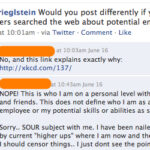Please don’t pay for e-portfolio software.
Instead, help or encourage the students to set up their own blogs. Let me quickly explain.
The original idea of an e-portfolio** was to help students keep a record of the work they did. This was intended to help them learn and show progress (the faculty and institution value) and get a job (the student’s value). While there is some tension between the faculty and the students with their respective values, both are good simple goals.
Companies were set up to build technology to facilitate this collection and distribution of information, but times changed and new methods have become clear, easier, more effective, and cheaper.
Blogs are a much better way to go.
A simple rule of thumb: it’s not an e-portfolio if Google can’t find it.
The Benefits of Blogs:
Students learn best from their peers. They learn in groups and in discussions. Encouraging students to post reflective learning on a blog allows them to network around their learning. This can be in the school, or, when the student is ready, out in the world. Learners can also find models to emulate – people in their major who are just a little better. According to the NSSE 2007 study, the biggest factor increasing engagement in education was the connections between students. Blogs help increase these connections.
The student can continue to use their blog after school, unlike private e-portfolio software. They can keep adding to it and connecting to others around their passion, interests, and work.
They are free. In our current climate, free gets bonus points.
Blogs increase the visibility of the students on Google. It’s not about being famous in the traditional sense, it’s about coming up under a search term that they care about and know about. This is how opportunities will come to them.
Blogs leave successful educational footprints and pathways through the institution. Most students will choose to leave their blogs open and public. The college can deliver these records of challenges, work, and success to other students. “Here you go, another student with your interest who took these steps from where you are and became successful.”
Blogs are highly flexible. Blogs can embed content from anything – Flickr (pictures), youtube (video), Twitter (micro-blog), etc. The blog itself is only limited by the imagination of the student.
Employers will love it. When they get near graduation and are looking for internships or jobs, the employer is highly likely to search the net for information. If they see the student has a long record of participation and reflection, this will go a long way to getting the interview.
A Few Common Objections:
Students don’t know how to blog.
Many of them do, but for those that don’t, learning blogging is much easier than most of the stuff they are supposed to learn. I dare you to click here to go to tumblr.com. If you can’t get a blog up in less than 4 minutes, I’ll buy you dinner in New York.
Faculty won’t do it.
Some will, some won’t. I’ve heard a number of times how hard faculty are to educate, and that’s wonderfully ironic, but it’s not about the faculty, it’s about the students. Give them videos and suggestions. Let the aggressive go-getters implement and show the rest of the students how. Of course, faculty are wary of more work. This is a student tool and the faculty can join in, or not.
We already have Blackboard.
Yes, and Blackboard does grading very well, but it does not help the students find jobs or create topic learning networks in the college and across the world. So use Blackboard for what it does well, and use free blogs because it helps the students.
Students won’t keep it current.
They might. The more topics can be made social, the more engagement will flow. Just look at Facebook. If they don’t keep it current, that’s okay. They still have an official transcript. Live assessment will provide support where it is needed. The point isn’t to give everyone success, college cannot do that. The point is to give everyone the best possible chance at success. A blog gives everyone that chance at no extra cost to the school.
They need privacy to learn. Being public makes them uncomfortable.
Being uncomfortable is a good sign growth is happening. Speaking in public makes everyone uncomfortable. If they only learn how to whisper in the ear of the professor, the college is not setting them up very well. Most importantly, on a blog, the student controls their own information. If they want to go back and make things private, they can do that at any time. If something is truly sensitive, it can be emailed.
Their work is not very good.
Imagine if 5-year-olds were kept from going to school because their speech was hard to understand. Don’t try to protect them from themselves. Do put them in a peer group where they can see models of success. The best way for them to improve is to be public in a group of peers, many of whom will be more skilled at something.
What if they complain about the school?
Then they will. They will do it on one of the 8 million outlets that the internet provides. A blog does not change this. It does, however, remove anonymity. This will mean the school will hear criticism that the author is standing behind. A dialogue can ensue. It’s much better than anonymous posts on unigo.com
The key, like many things these days, is to give the students the tools to organize themselves. Many of them will find the tools and do it on their own anyway. The opportunity is to help the other 20% + that are on the edge, just need a model and a little push.
(If you’d like to see a couple of great examples, check out the student leader bloggers here**.)




